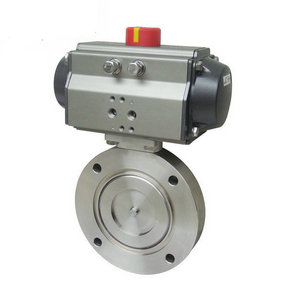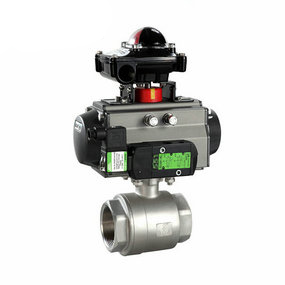Which one is better for pneumatic high vacuum butterfly valve? 6. Application of pneumatic ball valve Since rubber, nylon and polytetrafluoroethylene are commonly used as valve seat sealing ring materials for pneumatic ball valves, its service temperature is limited by the valve seat sealing ring materials. The cut-off function of pneumatic ball valve is completed by the metal ball pressing against the plastic valve seat under the action of medium (floating ball pneumatic ball valve). Under the action of a certain contact pressure, the seat seal ring has elastic-plastic deformation in some areas. This deformation can compensate the manufacturing precision and surface roughness of the ball and ensure the sealing performance of the pneumatic ball valve. Since the seat sealing ring of the pneumatic ball valve is usually made of plastic, the fire resistance and fire prevention of the pneumatic ball valve should be considered when selecting the structure and performance of the pneumatic ball valve. Especially in the petroleum, chemical, metallurgical and other departments, when using the pneumatic ball valve in the equipment and pipeline system with flammable and explosive media, more attention should be paid to fire resistance and fire prevention. Generally, pneumatic ball valves are recommended for pipeline systems with dual position adjustment, strict sealing performance, mud, wear, necking channel, rapid opening and closing (1/4 turn opening and closing), high pressure cut-off (large pressure difference), low noise, cavitation and gasification, small leakage to the atmosphere, small operating torque and small fluid resistance. Pneumatic ball valve is also suitable for pipeline systems with light structure, low pressure cut-off (small pressure difference) and corrosive media. Pneumatic ball valves can also be used in low-temperature (cryogenic) devices and pipeline systems. In the oxygen pipeline system of metallurgical industry, the pneumatic ball valve with strict degreasing treatment shall be used. When the main pipeline in the oil and gas pipelines needs to be buried underground, the full bore welded pneumatic ball valve shall be used. When the adjustment performance is required, the pneumatic ball valve with special structure and V-shaped opening shall be selected. In petroleum, petrochemical, chemical, electric power and urban construction, metal to metal sealed pneumatic ball valves can be selected for pipeline systems with operating temperature above 200 ℃.

Three way pneumatic ball valves are T-type and L-type. T-shape can make three orthogonal pipelines connect with each other and cut off the third channel, playing the role of diversion and confluence. The L three way pneumatic ball valve type can only connect two mutually orthogonal pipelines, and can not keep the third pipeline interconnected at the same time. It only plays the role of distribution. Technically, T-type pneumatic three-way pneumatic ball valve can replace L-type pneumatic three-way pneumatic ball valve, but L-type pneumatic ball valve cannot replace T-type pneumatic ball valve! During use, different structural forms shall be selected according to different working conditions, and T-type pneumatic ball valve can be DC, while L-type pneumatic ball valve cannot.
1. Pneumatic three-way pneumatic ball valve and three-way pneumatic ball valve adopt integrated structure in structure. The sealing type of four side valve seat has few flange connections and high reliability. The design realizes lightweight
2. Three way pneumatic ball valve has long service life, large flow capacity and low resistance
3. Three way pneumatic ball valve can be divided into single action and double action types according to the action type. The single action type is characterized by that once the power source fails, the pneumatic ball valve will be in the state required by the control system. The pneumatic three way pneumatic ball valve is a new type of three-way port switching pneumatic ball valve, which can be used to control the reversal, diversion or confluence of the three pipeline media. According to the different ball core structures, It can be divided into T-type or L-type. The difference between T-type pneumatic three-way pneumatic ball valve and L-type pneumatic three-way pneumatic ball valve is mainly due to the difference in internal structure, which cannot be seen from the appearance! The T-type pneumatic ball valve can make three orthogonal pipelines connect and cut off the third channel, and play the role of diversion and confluence. The L-type pneumatic ball valve can only connect two orthogonal pipelines, and can not keep the third pipeline connected at the same time, but only play the role of distribution. Flow Direction Diagram of Pneumatic Three way Pneumatic Ball Valve ① Flow Direction Diagram of T-type Pneumatic Three way Pneumatic Ball Valve From the above figure, we can see that T-type pneumatic ball valve is mainly used for the diversion or mixing of media, and L-type pneumatic ball valve is mainly used for reversing! L-type three-way pneumatic ball valve is used for distribution and switching without 3-way, which is more convenient to operate. There are only two valve positions, and it has positioning. It can be rotated 90 degrees without error; The T-type three way pneumatic ball valve has a wide range of channels and valve positions, and generally has no positioning. If it replaces the L-type, it will rotate 180 degrees. ② Flow Direction Diagram of L-type Pneumatic Three way Pneumatic Ball Valve Technically, T-type pneumatic three way pneumatic ball valve can replace L-type electric three way pneumatic ball valve, but L-type pneumatic ball valve cannot replace T-type pneumatic ball valve! During use, different structural forms shall be selected according to different working conditions, and T-type pneumatic ball valve can be DC, while L-type pneumatic ball valve cannot.




